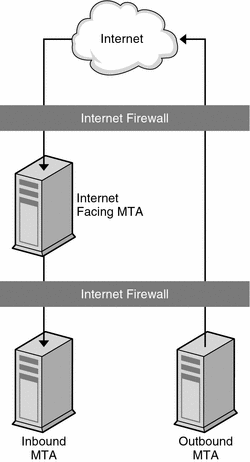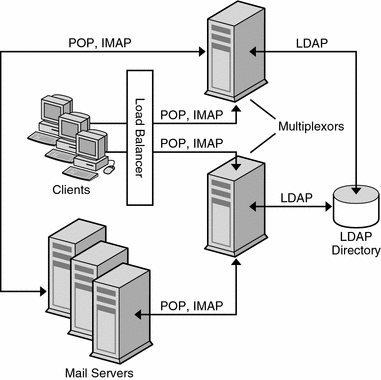Understanding Messaging Topology Elements
This section describes the most common elements in a messaging topology. Having some familiarity with the basic elements will make it easier for you to design your own topology.
The following topics are covered:
Messaging Topology Components
In Designing a Messaging Topology, you were introduced to three components of a messaging topology: Messaging Server, Directory Server, and clients. This section will describe other components in a basic messaging topology.
Messaging Server. Houses and maintains user mailboxes; it can also be a server that contains just the MTA portion of Messaging Server as described in Internet-facing MTA and MTA Relay.
Client. Accesses messaging services from Messaging Server (often through the Messaging Multiplexor).
Directory Server. Used by Messaging Server for name and alias lookup. Direct LDAP lookup determines where messages should be routed.
Messaging Multiplexor. Connects clients to the appropriate Messaging Server for retrieving messages.
Internet-facing MTA. Routes messages from the Internet and relays them across the firewall. Typically, a Messaging Server host is set up to perform this function.
MTA Relay. The inbound MTA routes incoming messages to valid addresses in the appropriate Messaging Server. The outgoing MTA accepts outgoing messages from clients, queries LDAP to find out where to send the message, then sends it off to the appropriate server or out across the firewall to the Internet. Typically, a Messaging Server host is set up to perform this function.
DNS Server. Resolves server names into IP addresses to allow messages to be routed to their proper address in the network.
Firewall. Restricts Internet access of your internal site. You might even have a firewall between departments in your organization.
Using MTAs to Protect Your Messaging System
You can use MTAs to protect your Messaging Server deployment, as well as to control the flow of message traffic to and from your site.
An Internet-facing MTA is a single point of contact that receives messages from sites external to your organization. An Internet-facing MTA sends the incoming messages across the firewall to the inbound MTA, typically another Messaging Server.
The inbound MTA then queries the directory to determine where to send the message within the organization. The Internet-facing MTA is located in the demilitarized zone (DMZ) of the firewall (between the external and internal walls of the firewall), and does not have access to any information about servers other than the inbound MTA.
The outbound MTA accepts outgoing messages from clients. It queries LDAP to find out where to send the message, then sends it off to the appropriate server or out across the firewall to the Internet. This offloads the MTA work from messaging servers that are used by users to retrieve messages. Figure 12–5 illustrates the idea.
Figure 12–5 MTAs in Messaging Topology

Using MMPs and MEMs
The MMP enables you to mask the layout of your Messaging Server hosts from your end users. Consequently, you assign users to a generic MMP or a load balancer without having them point to the specific server where their mail boxes reside. Message access clients point to the MMP for retrieving incoming messages.
When such a client connects and authenticates, the MMP looks up the user information in the directory to determine where the user’s messages are held. The MMP then connects the client to that specific server. The following figure shows how the MMP acts as a proxy for IMAP4 and POP3 connections to Messaging servers. You can multiplex HTTP services (like Messenger Express) by enabling the MEM feature. Figure 12–6 shows how multiplexors function in a Messaging Server environment.
Figure 12–6 MMP Overview

Use a load balancer in front of the multiple MMPs. It is unlikely that you would have a single MMP.
Using Gateways
Your organization might contain legacy messaging systems that use proprietary methods for messaging handling. Until you migrate your users, both messaging strategies must co-exist. To access these legacy systems, you can use an SMTP gateway, which enables SMTP connections between the new system and the other legacy systems. Usually legacy systems support SMTP connections so that the inbound MTA can route messages to it.
- © 2010, Oracle Corporation and/or its affiliates
